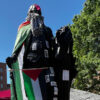The twin suicide bombings that rocked the Iranian embassy in Lebanon on Tuesday underscore the rising Sunni Arab backlash against Iran’s Syria policy.
The attack, which killed at least 25 people, including the Iranian cultural attaché, also wounded more than 140 people in the Hezbollah-controlled neighborhood in southern Beirut.
The attack was quickly claimed by the Abdullah Azzam Brigades, a Sunni Islamist terrorist group linked to al-Qaeda. The declared aim was to take revenge for Iranian and Hezbollah efforts to prop up the beleaguered Bashar al-Assad regime in neighboring Syria. A spokesman for the terrorist group warned that attacks would continue until Iran and Hezbollah end their meddling in Syria.
But the deeper meaning of the attack is that Shiite Iran and Sunni Arab terrorists that Iran has frequently colluded with are now increasingly clashing. Tehran has long had a murky relationship with al-Qaeda, which is inspired by a Sunni Islamist ideology that conflicts with Iran’s radical Shia brand. But ideological differences were trumped by the fact that the two shared common enemies: the United States, Israel, and moderate Arab governments.
According to the 9/11 Commission Report (page 61), Iran has long cooperated with al-Qaeda:
In late 1991 or 1992, discussions in Sudan between al Qaeda and Iranian operatives led to an informal agreement to cooperate in providing support—even if only training—for actions carried out primarily against Israel and the United States. Not long afterward, senior al Qaeda operatives and trainers traveled to Iran to receive training in explosives. In the fall of 1993, another such delegation went to the Bekaa Valley in Lebanon for further training in explosives as well as in intelligence and security. Bin Ladin reportedly showed particular interest in learning how to use truck bombs such as the one that had killed 241 U.S. Marines in Lebanon in 1983.
After the U.S. overthrow of the Taliban, which provided al-Qaeda sanctuary in Afghanistan, Iran offered refuge to the terrorists and facilitated their travel between Afghanistan and Iraq. CNN reported that the Pentagon made plans in 2002 to raid an al-Qaeda safe house in the Iranian town of Chalus, but the raid was called off due to a lack of precise intelligence.
U.S. intelligence agencies concluded that a May 2003 terrorist bombing in Saudi Arabia was planned and ordered by al-Qaeda elements located in Iran, according to The Washington Post. Senior al-Qaeda leaders—including Osama bin Laden’s son, Saad, and al-Qaeda’s military commander Saif al-Adel—lived in Iran for many years under the protection of the elite Quds Force of the Islamic Revolutionary Guard Corps.
Although Tehran periodically restricted its activities under some form of house arrest, it relaxed its grip and allowed many al-Qaeda cadres to leave Iran beginning in late 2008. Al-Qaeda’s Iraq franchise periodically killed Iranian pilgrims traveling to Iraq’s Shia holy sites, but its chief targets were U.S. troops and the Iraqi government.
Iran’s collusion with various factions of al-Qaeda has persisted. In April, Canadian authorities arrested two foreign Arabs who planned to bomb a train bound for New York City and had received “direction and guidance” from “al-Qaeda elements located in Iran.”
But now the Lebanon bombings have opened up a new chapter in Iran’s relations with al-Qaeda. More attacks on Iranian targets in Lebanon and elsewhere are likely to follow, and Tehran is sure to respond in kind.
Iran is being drawn into a war with al-Qaeda, a Frankenstein monster that it has long aided and abetted.

























